- COBIT Interview Questions and Answers
- COBIT vs ITIL: IT Governance Frameworks
- ITIL Interview Questions
- An Introduction to ITIL
- ITIL Lifecycle: Continual Service Improvement (CSI)
- ITIL Lifecycle : Service Design
- ITIL Lifecycle: Service Operation
- ITIL Lifecycle : Service Strategy
- ITIL Lifecycle: Service Transition
- ITIL – Service Management As A Practice
- ITSM vs ITIL
We are currently living in an era where the development of technology is attaining new heights every day along with organizational growth. Whether it be the IT cell of a government sector like defense or a private sector like a software company, all of them are enhancing their working area with high advancements every single day. In such a case, it is getting a pain in the head for managers to manage all of their resources to get maximum profitability. Keeping this in mind, the Information Systems Audit & Control Association (ISACA) has introduced its COBIT platform, which is helping a lot of managers across the globe nowadays.
If you would like to become a COBIT certified professional, then visit Mindmajix - A Global online training platform: "COBIT training and certification Course". This course will help you to achieve excellence in this domain.
Q.1) What is COBIT?
Ans) COBIT stands for Control Objectives for Information and Related Technology. It is a business framework that is used for the management and governance of the IT enterprise. Powered from ISACA, Cobit packs the latest methodology in management techniques and enterprise governance. Furthermore, it offers globally accepted practices, principles, models, and analytic tools to increase the reliability of information systems. Its latest version is termed as COBIT 5 which is an upgraded version of Cobit 4.1.
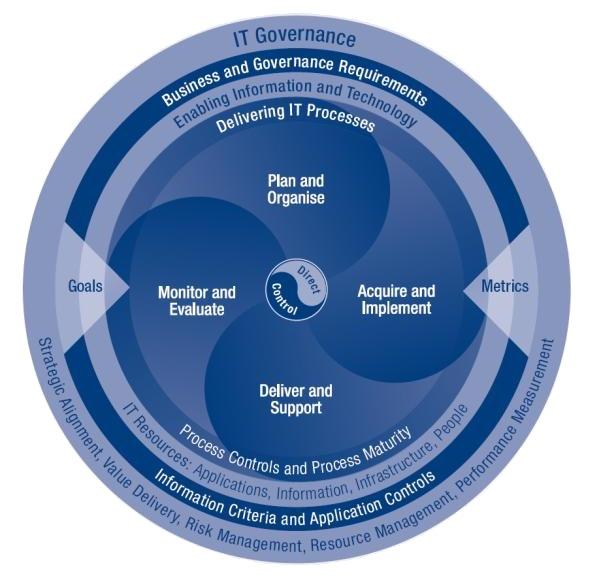 [Source: isaca.org]
[Source: isaca.org]The Cobit 5 is a mixture of additional major frameworks, resources, and standards, including ISACA’s Risk IT and Val IT, ITIL (Information Technology Infrastructure Library), and other related standards from ISO. Cobit comes with a lot of additional facilities that can help you in achieving the desired business goals and managing enterprise IT. All of its additional features can be seen in the following points given below:
- It emphasizes regulatory compliance.
- It helps organizations to enhance the value obtained from IT.
- It enables alignment
- It simplifies the implementation of the enterprise’s IT governance and control framework.
Q.2) Why Use Cobit 5?
Ans) Managers across the globe face new challenges every day in their organizations. New user demands, risk scenarios, and industry-specific regulations emerge every single day to challenge the stability of an organization.
With the development of technology, enhancing the value of intellectual property, managing risk, and security, and assuring compliance via effective IT management and governance has attained a whole new level. It has become very important as well as challenging to take care of all these factors. Here, you will find Cobit as the best guide to reach perfection.
There is no other framework based on the enterprise IT available in the market that offers the same benefits as Cobit. It helps all sizes of enterprises to maintain their stability and focus on their growth. The below-mentioned ones are some points that might help you in getting precise answers about why you must use Cobit for your organizations.
- It maintains high-quality information for supporting business decisions.
- It helps in achieving strategic goals via the innovative and effective use of IT.
- It helps in achieving operational excellence via reliable, efficient application of technology.
- It maintains IT-related risk at an acceptable level.
- It helps in optimizing the cost of IT services.
- It supports compliance with contractual policies and agreements, relevant regulations, and laws.
These are some points that might help you in choosing this technology. As we have already mentioned above that COBIT 5 is the latest version offered by ISACA, hence, it will is the most preferred technology if we talk about IT governance and management.
Q.3) Who Uses Cobit 5?
Ans) Cobit 5, the latest version offered by ISACA, is compatible with every kind and size of the organization. COBIT 5 is useful and generic for every size enterprises, whether commercial, public, or in the non-profit sector. COBIT 5 is used by the ones who have primary responsibility for business processes and technology. Moreover, it is used globally by persons who depend on technology for reliable and relevant information. The individuals who are focused on providing quality, reliability, and control of information as well as related technology also use COBIT 5 to enhance their performance. Most of the Cobit 5 users include consultants and enterprise executives in the following sectors:
- Audit and Assurance
- Compliance
- IT Operations
- Governance
- Risk and Security Management
Q.4) What is the Cobit Framework?
Ans) As we have already mentioned above, COBIT allows you to control all the IT operations of your company so that you can minimize the risk and enhance the work power in a disciplined manner. Cobit allows all the managers to fill the gap between technical issues, control requirements, and business risks.
Moreover, it enables clear policy development, as well as fine practice for IT, control throughout your organization. In the recent update of Cobit, ISACA introduces some new concepts and terminologies that include 40 management and governance objectives to establish a governance program. However, the framework still plays fine with additional IT management frameworks such as TOGAF, CMMI, and ITIL.
The main difference between Cobit and other frameworks is that it offers keen attention to risk management, security, and information governance. The overall Cobit framework is designed to provide businesses an enhanced and flexible experience of customizing an IT governance strategy. The main focus of Cobit remains stable on the following domains mentioned in the below-given points:
- Planning and Organizing
- Delivery and Support
- Acquiring and Implementation
- Monitoring and Evaluating
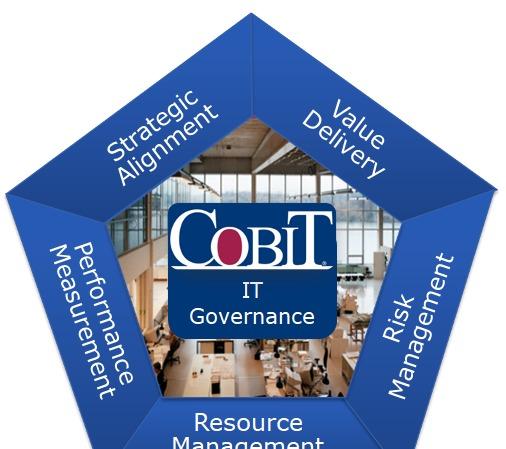
[Source: isaca.org]
Apart from this, if we talk about the key points of Cobit framework’s working, it is entirely aimed at the following points given below:
- Strategic Alignment
- Value Delivery
- Performance Management
- Risk Management
- Resource Management
Related: Cobit vs. ITIL
Q.4)Principles of COBIT Framework
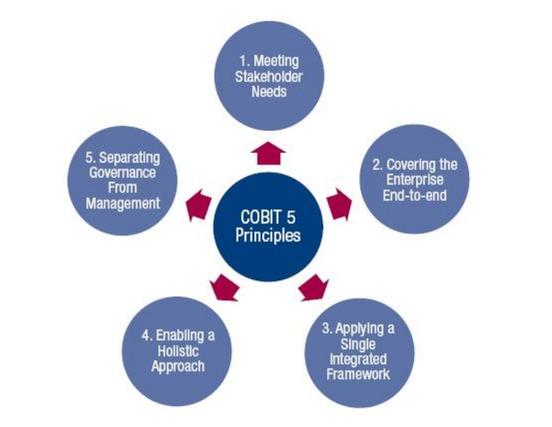
[Source: isaca.org]
Ans) Being a highly reliable and used IT management framework across the entire globe, COBIT has its own set of rules or principles that make it one of the leading technologies in the market. COBIT has a total number of 5 principles that make it a complete IT management and governance framework. All of these principles are listed here, kindly take a look at them and get detailed knowledge about each one of them:
Meeting stakeholder needs
The first and most important principle of COBIT is ‘Meeting Stakeholder Needs’. It simply means that this framework helps you in satisfying all the needs and requirements of your stakeholders by offering them appropriate values. Delivering desired enterprise stakeholder values simply requires fine management and governance of the IT assets.
All the enterprise boards, management, and executives will have to embrace IT just like any other essential part of the business. Keeping this in mind, the COBIT framework offers a comprehensive framework that assists the organizations in achieving their desired goals and deliver values via effective management and governance of the enterprise IT.
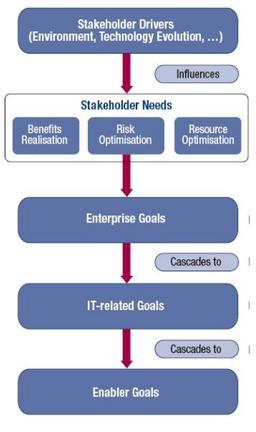
[Source: isaca.org]
To attain the desired results, all the stakeholder needs have to be transformed into an actionable enterprise strategy. After that, the strategy can simply lead your enterprise in the right direction towards your desired goals. To make this a bit easier, the COBIT 5 goals cascade helps in translating your stakeholder needs into actionable, specific, and customized goals within the context of IT-related goals, enabler goals, and enterprise goals.
Covering the enterprise end to end
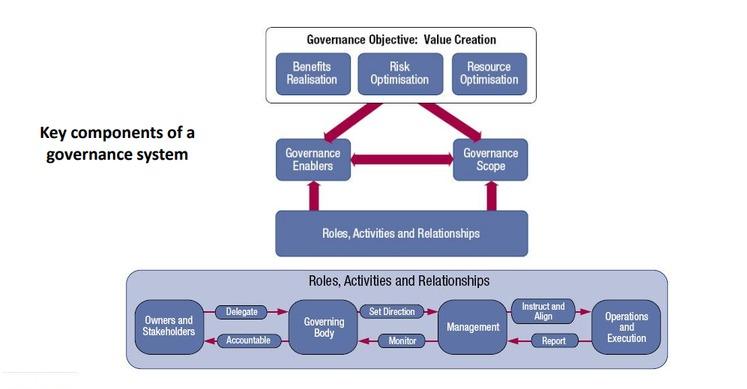
[Source: isaca.org]
The second principle of COBIT says that you must cover the entire enterprise or organization end to end so that you will be able to manage and operate every section with equal attention. A flowchart in the above-given image shows every section or part of an organization along with the working of that section. We can easily see that all the parts of an enterprise are correlated with the other one. It simply means that any kind of issue in any section will also create some issues in the other one related to it. For this, the COBIT framework packs a facility that can cover all the sections and parts of your enterprise, so that you will be able to keep an eye on them without facing any hurdle.
Applying a single integrated framework
COBIT comes with an ability to align or integrate with all the latest relevant frameworks and standards used by other enterprises. The major ones of them are CMMI, PMBOK/Prince2, TOGAF, ISO 27000 series, ITIL, ISO 38500, ISO 31000, ISO 9000, COSO ERM, COSO, etc. By the availability of this facility, COBIT can be used as the overarching management and governance framework integrator. It simply means that it can be integrated with any of these above-given frameworks and standards to make your business achieve new heights. In simple words, we can say that the COBIT is a one-way solution or panacea to be integrated with any of the leading management and governance IT frameworks.
Enabling a holistic approach
The fourth principle of the COBIT framework is to enable a holistic approach in your organizational work, which means your entire organization must work as a single unit. For this, the latest version of COBIT defines a specific set of enablers to support the implementation of a comprehensive management and governance system for enterprise IT.
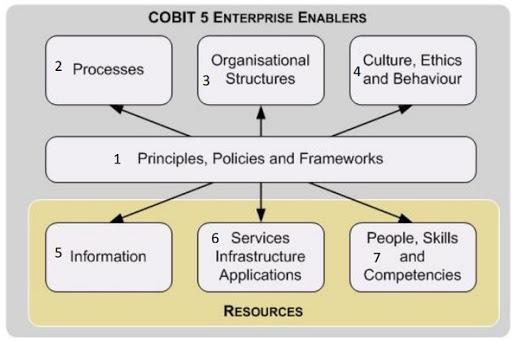
[Source: isaca.org]
COBIT enablers can be termed as the factors that collectively as well as individually influence the work of something. These factors are driven by the goals cascade in the COBIT framework. The COBIT enablers can simply be divided into seven parts that can also be seen in the below-given pointers.
- Principles, policies, and frameworks.
- Processes.
- Organizational structures.
- Culture, ethics, and behavior.
- Information.
- Services, infrastructure, and applications.
- People, skills, and competencies.
Additional details related to these COBIT enablers can be seen via official pfd issued by the company.
Separating governance from management
The fifth principle of COBIT focuses on the separate implementation of governance and management in the organization. COBIT advocates that the implementation of governance and management processes in an organization must be like the below-mentioned image. Kindly take a look at it to get an elaborated view of a stable organization.
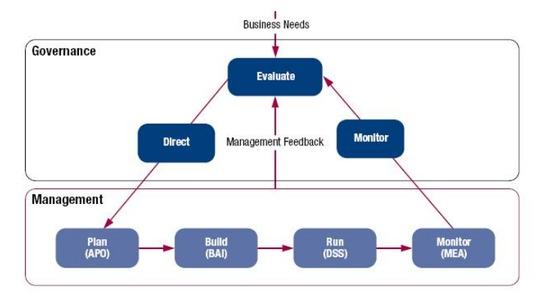
[Source: isaca.org]
Governance in an organization can be termed as the action or process that ensures the achievement of enterprise objectives by evaluating stakeholder needs, conditions, and options. Moreover, it also takes care of setting direction via prioritization and decision making as well as monitoring compliance, progress, and performance against fixed objectives and directions. On the other hand, the management of organization plans, builds, runs, and monitors different activities in alignment with the direction prefixed by the governance body to achieve the enterprise objectives.
In simple words, we can say that the COBIT framework brings together and works based on these five principles, which allows your enterprise to build an effective management and governance framework. This framework is entirely based on a holistic set of seven enablers, which optimize IT investment and use it for the benefit of all the stakeholders. Additional information related to these 5 COBIT principles can simply be seen by accessing the official pdf of the company.
Q.5) Significance of COBIT in Business industry and IT Infrastructure
Ans) COBIT is undeniably a great tool for the management and governance of your enterprise IT. The leading framework is getting used by numerous organizations across the globe, whose primary responsibilities are related to business processes and similar technologies. In simple words, all the businesses and organizations, which are dependent on technology for relevant and reliable technologies, are using this framework. Moreover, COBIT is getting used by both private and government sector organizations, as it helps in enhancing the stability and sensibility of IT processes.
However, there are also many businesses and enterprises present across the globe that are not familiar with the COBIT framework or the benefits associated with it for their company. Now, your mind might pop up with a question that why should businesses care what this IT framework can do for them? And the answer is, it can increase productivity like never before. Moreover, it is entirely integratable with a lot of other common resources. COBIT aims to optimize the business IT structure. Whether it be your day to day tasks or long term goals, COBIT helps you achieve them like a true companion.
Q.6)Importance of COBIT Certification
Ans) COBIT certification can boost up your career if you are heading up in your organization. COBIT certification prepares professionals and individuals for global challenges of the IT business processes. Moreover, it also delivers a substantial amount of expertise on the following points mentioned below:
- IT management issues and how they can affect the working of an organization.
- Principles of enterprise IT and IT governance, while establishing the connection between governance and management.
- Accessing the ways of achieving COBIT’s 5 basic principles as well as their enablers.
- Discussing COBIT 5.0 concerning its process reference model and goal cascade.
Apart from these, you can also get deep knowledge of IT management and governance, by which you will get to know how a business or an enterprise runs. You can simply take a look at Mindmajix COBIT Training with the help of which you can easily get the certification along with a rock strong knowledge base of this technology without facing any hurdle.
Q.7)Who Benefits with COBIT Framework?
Ans) All the professionals, who are in a position to understand the nuances of business management and IT governance practices are the suitable ones to benefit from the COBIT framework. We are entirely aware that all IT enterprises and organizations can make their work easy and bug-free by using this framework. However, here we are showcasing the list of all kinds of professionals that are suitable to use this technology or platform.
- CIOs / IT Directors / IT Managers
- Process Owners
- Risk Committee
- COBIT 4.1 and earlier users
- Audit Committee Members
- All the IT professionals in risk, audit, governance, security, and assurance sectors.
So, if you are working as one of these above-given professionals, COBIT can prove to be a great tool to streamline your work process and remove all the risk factors.
Conclusion
Now, we have elaborated on all the key points and essential information related to the COBIT framework in this article. COBIT is doubtlessly a great tool to organize your enterprise IT working and remove risk factors. This will allow you to feel free and be completely focused on organizational growth and enhanced production. Hence, if you own an IT firm, business, or organization, COBIT can prove to be a great tool for your overall growth.
Apart from this, if you are serving for an organization in the management or governance section, you can take great advantage of this framework to grow further in your career. You can easily get all the required details related to the COBIT Framework via this article and can decide whether to choose it as your companion or not. Choose wisely and do well.
 On-Job Support Service
On-Job Support Service
Online Work Support for your on-job roles.

Our work-support plans provide precise options as per your project tasks. Whether you are a newbie or an experienced professional seeking assistance in completing project tasks, we are here with the following plans to meet your custom needs:
- Pay Per Hour
- Pay Per Week
- Monthly
| Name | Dates | |
|---|---|---|
| COBIT Training | Dec 23 to Jan 07 | View Details |
| COBIT Training | Dec 27 to Jan 11 | View Details |
| COBIT Training | Dec 30 to Jan 14 | View Details |
| COBIT Training | Jan 03 to Jan 18 | View Details |

Soujanya is a Senior Writer at Mindmajix with tons of content creation experience in the areas of cloud computing, BI, Perl Scripting. She also creates content on Salesforce, Microstrategy, and Cobit. Connect with her via LinkedIn and Twitter.







